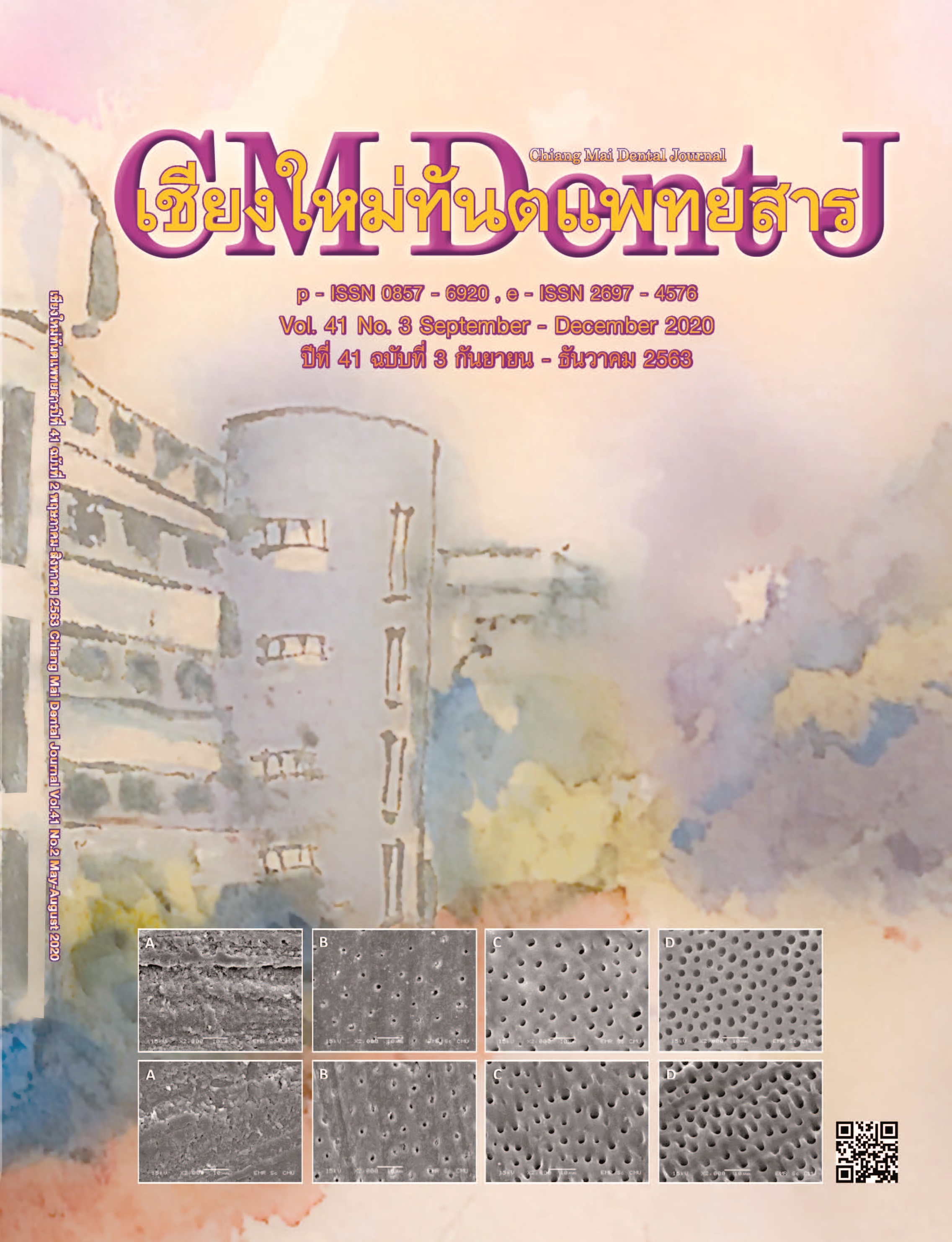Efficacy of light curing unit prototype on surface hardness of resin composite as a function of tilt angle
Main Article Content
Abstract
Purpose : To evaluate the efficacy of light curing unit (LCU) prototype and to compare microhardness values of resin composite at different tilt angles.
Materials and methods : Ninety composite resin specimens were prepared using plastic molds (6.0 mm internal diameter and 2 mm. depth) and divided into nine experimental groups (n=10) : Three LED light curing units (Celalux2, Bluephase and SangSeeFah) and three different tilt angles (α = 90°, 80°, 70°). After 24 h, Vicker-hardness measurement was made on the top and bottom surfaces of the specimen. The values were analyzed by two-way ANOVA and Tukey’s test (P < 0.05).
Results : The microhardness values showed no significant differences between different tilt angles while using SangSeeFah and Bluephase. By increasing the tilt angle of Celalux2 the top microhardness showed significantly decreased. and Celalux2 had the lowest hardness compared to all LCU at all angles.
Conclusion : The tilt angle of Celalux2 had an effect on microhardness of resin composite. Different light curing units gave the different levels of resin composite polymerization.
Article Details
References
Giorgi MC, Lima DA, Marchi GM, Ambrosano GM, Aguiar FH. Influence of softening test and light-activation protocols on resin composite polymer structure. Eur J Dent 2014; 8(1): 9-14.
Bakkal M, Yılmaz B, Durmus A, Durmus Z, Ozalp S. Polymerization characteristics of colored compomers cured with different LED units. J Appl Biomater Funct Mater 2019; 17(1): doi: 10.1177/2280800019827805.
Jiménez-Planas A, Martín J, Abalos C, Llamas R. Developments in polymerization lamps. Quintessence Int 2008; 39(2): 74-84.
Nomoto R. Effect of light wavelength on polymerization of light-cured resins. Dent Mater J 1997; 16(1): 60-73.
Taira M, Urabe H, Hirose T, Wakasa K, Yamaki M. Analysis of photo-initiators in visible-light-cured dental composite resins. J Dent Res 1988; 67(1): 24-28.
Leonard DL, Charlton DG, Roberts HW, Cohen ME. Polymerization efficiency of LED curing lights. J Esthet Restor Dent 2002; 14(5): 286-295.
Price RB, Felix CA, Andreou P. Evaluation of a second-generation LED curing light. J Can Dent Assoc 2003; 69(10): 666.
Campregher UB, Samuel SM, Fortes CB, Medina AD, Collares FM, Ogliari FA. Effectiveness of second-generation light-emitting diode (LED) light curing units. J Contemp Dent Pract 2007; 8(2): 35-42.
Owens BM, Rodriguez KH. Radiometric and spectrophotometric analysis of third generation light-emitting diode (LED) light-curing units. J Contemp Dent Pract 2007; 8(2): 43-51.
Price RB, Felix CA, Andreou P. Evaluation of a dual peak third generation LED curing light. Compend Contin Educ Dent 2005; 26(5): 331-338.
Konerding KL, Heyder M, Kranz S, et al. Study of energy transfer by different light curing units into a class III restoration as a function of tilt angle and distance, using a MARC Patient Simulator (PS). Dent Mater 2016; 32(5): 676-686.
Nozu S, Matsuda T, Iwata N, Yoshikawa K, Yamamoto K. Influence of Light Curing Energy on Dentin Bond Strength. Jpn J Conserv Dent 2015; 58: 446-455.
Lynch F. COB vs. POB, an Alternate LED Directional Point Light Source. Permlighttechnologies.tech; 2017 Available from: http://permlight.com/sites/default/files/White%20Paper%20COB%20vs%20POB%201.3.17_0.pdf
Wang L, D’Alpino PH, Lopes LG, Pereira C. Mechanical properties of dental restorative materials: relative contribution of laboratory tests. J Appl Oral Sci 2003; 11(3): 162-167.
Poskus LT, Placido E, Cardoso PE. Influence of placement techniques on Vickers and Knoop hardness of class II composite resin restorations. Dent Mater 2004; 20(8): 726-732.
Price RB, Labrie D, Rueggeberg FA, Sullivan B, Kostylev I, Fahey J. Correlation between the beam profile from a curing light and the microhardness of four resins. Dent Mater 2014; 30(12): 1345-1357.
Catelan A, de Araujo LS, da Silveira BC, et al. Impact of the distance of light curing on the degree of conversion and microhardness of a composite resin. Acta Odontol Scand 2015; 73(4): 298-301.
De Araújo CS, Schein MT, Zanchi CH, Rodrigues SA Jr., Demarco FF. Composite resin microhardness: the influence of light curing method, composite shade, and depth of cure. J Contemp Dent Pract 2008; 9(4): 43-50.
Hegde V, Jadhav S, Aher GB. A clinical survey of the output intensity of 200 light curing units in dental offices across Maharashtra. J Conserv Dent 2009; 12(3): 105-108.
Rueggeberg FA, Caughman WF, Curtis JW Jr. Effect of light intensity and exposure duration on cure of resin composite. Oper Dent 1994; 19(1): 26-32.
Shortall AC, Harrington E, Wilson HJ. Light curing unit effectiveness assessed by dental radiometers. J Dent 1995; 23(4): 227-232.
McCabe JF, Carrick TE. Output from visible-light activation units and depth of cure of light-activated composites. J Dent Res 1989; 68(11): 1534-1539.
Flury S, Hayoz S, Peutzfeldt A, Husler J, Lussi A. Depth of cure of resin composites: is the ISO 4049 method suitable for bulk fill materials? Dent Mater 2012; 28(5): 521-528.
Bouschlicher MR, Rueggeberg FA, Wilson BM. Correlation of bottom-to-top surface microhardness and conversion ratios for a variety of resin composite compositions. Oper Dent 2004; 29(6): 698-704.
Cardoso KA, Zarpellon DC, Madruga CF, Rodrigues JA, Arrais CA. Effects of radiant exposure values using second and third generation light curing units on the degree of conversion of a lucirin-based resin composite. J Appl Oral Sci 2017; 25(2): 140-146.
Leonard DL, Charlton DG, Hilton TJ. Effect of curing-tip diameter on the accuracy of dental radiometers. Oper Dent 1999; 24(1): 31-37.
Nitta K. Effect of light guide tip diameter of LED-light curing unit on polymerization of light-cured composites. Dent Mater 2005; 21(3): 217-223.
Harrington L, Wilson HJ. Determination of radiation energy emitted by light activation units. J Oral Rehabil 1995; 22(5): 377-385.


